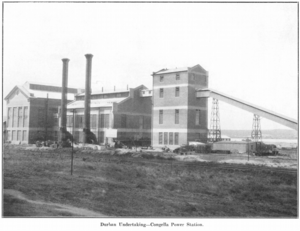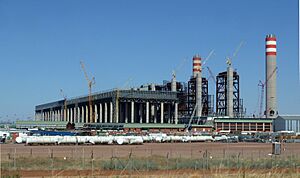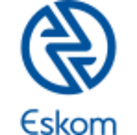Eskom facts for kids
 |
|||
| Public utility | |||
| Traded as | JSE: BIESKM | ||
| Industry | Energy | ||
| Founded | 1 March 1923 | ||
| Headquarters | Sunninghill, Sandton, South Africa | ||
|
Key people
|
|
||
| Services | Electricity generation, transmission and distribution | ||
| Revenue | US$ 13.82 billion |
||
US$ -1.28 billion |
|||
| Total assets | US$52.84 billion |
||
|
Number of employees
|
|||
| Subsidiaries |
List
Amazing Amanzi (Pty) Ltd
EON Solutions Africa (Pty) Ltd |
||
|
|||
Eskom Hld SOC Ltd, or simply Eskom, is South Africa's main electricity company. It was started in 1923 as the Electricity Supply Commission (ESCOM). Eskom is the biggest producer of electricity in Africa. It was once one of the top electricity companies in the world.
Eskom generates about 95% of the electricity used in South Africa. This is about 45% of all electricity used in Africa. The company has different parts: Generation (making electricity), Transmission (moving it through power lines), and Distribution (sending it to homes and businesses). Eskom operates important power stations like Matimba Power Station and Koeberg Nuclear Power Station, which is Africa's only nuclear power plant.
Eskom has faced challenges, including rolling blackouts (called load shedding). These power cuts have happened since 2008. The company has also had problems with delays and high costs for new power plants. Because of these issues and large debts, Eskom has been undergoing changes.
In 2021, a plan was announced to help South Africa move from coal power to renewable energy. This plan involves funding from developed countries.
Contents
History of Eskom
Before Eskom was created, cities and private companies provided electricity. Kimberley was one of the first places to use public electricity. It installed electric streetlights in 1882 to make the city safer at night. Cape Town followed in 1895 with its own electric streetlights.
Eskom was officially founded in 1923 by the Electricity Act of 1922. This law allowed Hendrik Johannes van der Bijl to be appointed as its first chairman. In 1987, the company changed its name to Eskom. This name combined parts of its old names, ESCOM and EVKOM.
The Electricity Act said that Eskom should only sell electricity at cost. This meant it wasn't supposed to make a profit. It raised money by borrowing from banks and later through government-backed loans. The first power stations built by Eskom were the coal-fired Congella Power Station in Durban and Salt River Power Station in Cape Town. Both were finished in 1928.
Another early Eskom power plant was a coal-fired station in Witbank. It was completed in 1935 to provide power to the mining industry. Eskom later bought out a private company called Victoria Falls and Transvaal Power Company in 1948. After World War II, South Africa had power shortages. Eskom then made agreements with mines to save electricity.
Growing Power: 1960-1994
Between 1960 and 1990, Eskom greatly increased its ability to produce power. It grew from 4,000 MW to 40,000 MW. This was to keep up with South Africa's fast economic growth. During this time, Eskom also built a large network of power lines across the country.
The company built many big, standard coal-fired power plants. These plants were very efficient and could produce electricity at a low cost. They were often called "six-packs" because they had six large generator units.
In 1974, Eskom was told to start building the Koeberg Nuclear Power Station. This plant was meant to provide power to Cape Town. It also supported the South African government's nuclear program.
In the 1970s, Eskom needed to raise electricity prices to pay for its big expansion plans. A special commission suggested changes for the company. Eskom then started taking out international loans to raise money. The number of Eskom employees was also reduced in the late 1980s.
Changes After 1994: 1994-2007
After the democratic elections in 1994, Eskom changed its focus. It worked to bring electricity to homes that had not had it before. It also aimed to provide low-cost electricity to help the economy grow.
In the late 1990s, the government tried to privatise parts of Eskom. Because of this, Eskom's requests for money to build new power stations were turned down. Later, former president Thabo Mbeki said this was a mistake that hurt the South African economy.
Power Cuts and New Plants: 2007-Present
In 2006, Eskom started "load shedding" (planned power cuts) in the Western Cape. This was due to problems at the Koeberg Nuclear Power Plant. In January 2008, load shedding began across the whole country. This happens when there isn't enough electricity to meet demand. Eskom encourages people to save power during busy times to reduce these cuts.
After the power shortages in 2007, Eskom began a big program to build more power plants. The government decided to focus on building more large coal-fired power stations.
In 2016, Eskom said it wanted to use more nuclear power. It even started training programs for nuclear operators. However, in 2018, Eskom said it could not afford a new nuclear plant. This was because its profits had dropped and its costs were rising.
In 2017, Eskom was involved in a major corruption scandal. This involved the Gupta family and the government of then-President Jacob Zuma.
The National Energy Regulator of South Africa (NERSA) did not allow Eskom to increase electricity prices by a large amount in 2018/19. NERSA said Eskom had too many employees, which cost the company a lot of money.
In February 2019, Eskom started another round of emergency load shedding. This was due to breakdowns at power stations and low fuel supplies. Other reasons included past corruption and delays in finishing new power plants like Medupi and Kusile. These power problems contributed to a drop in South Africa's economic growth.
In December 2019, President Cyril Ramaphosa and other ministers met with Eskom's leaders. The president said some blackouts were due to sabotage at the Tutuka Power Station. He announced plans to end load shedding. In January 2020, Eskom's chairperson, Jabu Mabuza, resigned.
During the COVID-19 lockdown in 2020, power supply was stable because less electricity was needed. But in July 2020, load shedding started again. In the winter of 2023, South Africa experienced severe power cuts, sometimes lasting 12 hours a day. These cuts significantly affected the country's economy.
Eskom's Logos
Eskom's logo has changed over time. For a short period in 1986, Eskom had no logo. Its first logo had the letters "ESC" in a circle. In 1987, it changed to a blue shield with a lightning bolt. The current logo, from 2002, uses a circle instead of a shield but keeps the lightning bolt design.
Changing Eskom's Structure
In 1998, a government report suggested breaking Eskom into separate companies for generation and transmission. This was meant to improve power supply, but it didn't happen then.
In February 2019, President Cyril Ramaphosa announced that Eskom would be split into three new state-owned companies. These would focus on generation, transmission, and distribution. This was to help manage Eskom's serious problems and huge debts. At that time, Eskom had a debt of R419 billion (about US$30.8 billion).
In February 2019, the Department of Public Enterprises said Eskom was "technically insolvent." This meant it might not be able to operate without more loans. The Finance Minister then announced a R69 billion (US$5 billion) bailout for Eskom over three years to help its financial situation.
Transmission Company
As part of the changes, a new company called the National Transmission Company of South Africa (NTCSA) was created. It is a part of Eskom but has its own board. The NTCSA is responsible for managing the thousands of kilometres of power lines that carry electricity from power stations to where it is needed.
The NTCSA plans to add about 4,800 km of new high-voltage transmission lines over the next 10 years. In July 2023, NERSA approved the NTCSA to operate South Africa's transmission system.
Trade Union Response
The trade union COSATU was worried about job losses from Eskom's breakup. They organized a national strike. This led to the government seemingly pausing its plans to break up the company.
In July 2019, the outgoing Eskom CEO said the company was in a "death spiral" and needed to change. When André de Ruyter became CEO, other trade unions said they would fight any changes that might lead to job losses.
In December 2019, COSATU suggested using money from the Public Investment Corporation (PIC) to reduce Eskom's debt. In return, COSATU wanted workers to keep their jobs. Other unions were against this idea, saying it could put public employees' pensions at risk.
Job Changes
Between 2020 and 2021, about two thousand Eskom employees left their jobs. More job changes are expected as the company continues to restructure.
How Much Power Eskom Makes
Eskom is the only electricity provider in South Africa. It has over 16 million customers, which is about one-third of the country's population.
Coal and Gas Power Stations
Eskom operates many power stations that use coal or gas. These include:
- Arnot Power Station in Mpumalanga
- Duvha Power Station in Mpumalanga
- Kendal Power Station in Mpumalanga
- Kusile Power Station in Mpumalanga (still being completed)
- Medupi Power Station in Limpopo (now fully operational)
- Tutuka Power Station in Mpumalanga
Renewable and Nuclear Power Stations
Eskom also has power stations that use renewable energy sources like water (hydroelectric) and wind, as well as nuclear power. These include:
- Drakensberg Pumped Storage Scheme (hydroelectric) in Free State
- Gariep Dam (hydroelectric) on the Free State-Eastern Cape border
- Ingula Pumped Storage Scheme (hydroelectric) in KwaZulu-Natal
- Koeberg Power Station (nuclear) in Western Cape
- Sere Wind Farm (wind) in Western Cape
Future Plans
Eskom has plans for new projects to make even more electricity. These include:
- Tubatse Pumped Storage Scheme – 1500MWe (hydroelectric)
- Wind 500 – 550MWe (wind power)
- Tasakoolo Wind farm 200 – 200Mwe (wind power)
Investing in Green Energy
Eskom is looking into solar energy. In October 2019, it asked companies to help install solar equipment at some power plants. The African Investment Forum has also raised over $40.1 billion to develop new renewable energy projects. This aims to help South Africa move away from coal and focus more on wind and solar power.
In April 2025, Eskom signed an agreement with Exxaro to help reduce its carbon emissions. In May 2025, Eskom invited companies to build a pilot green hydrogen facility. This is part of its goal to have net-zero carbon emissions by 2050. Eskom is also working to set up a separate renewable energy business.
South Africa's Energy Plan
South Africa has a plan called the Integrated Resource Plan (IRP). This plan supports using different types of energy. It aims to meet South Africa's energy needs by focusing on renewable energy sources. The IRP plans to invest in solar and wind power. It also wants to increase investment in hydroelectric power.
More Green Investments
South Africa is working towards a greener future. It has agreed to the Paris Agreement, which means it needs to reduce its carbon emissions and rely less on coal. A new US$11 billion Green-Energy Initiative aims to develop solar and wind power. This plan will provide loans to Eskom to help it close coal power plants and build more renewable energy structures.
Other Important Infrastructure
In 2002, Eskom received a special license to operate its network. It started a project to install fibre optic cables along 10,000 kilometres of its power lines. This helps Eskom monitor its electricity network in real-time.
How Eskom is Managed
In 2011, many Eskom board members were removed by the government. From 2015 to 2017, Ben Ngubane was the chairperson, and Brian Molefe was the CEO. Their time at Eskom was controversial due to their links with the Gupta family. There were concerns that the company was being used for "state capture," where private interests unfairly influence government decisions.
In early 2018, after a new government was formed, many Eskom board members and leaders were replaced. This was due to concerns about corruption and poor management.
Phakamani Hadebe became the acting CEO in May 2018. He resigned a year later, saying the job was difficult and he had health issues. His resignation led to discussions about the challenges of managing the company.
Six months after Hadebe left, André de Ruyter was appointed CEO. He resigned in December 2022. It was reported that he did not receive enough support to succeed in his role.
Eskom's Money Situation
Eskom's financial situation became very serious in 2018 and 2019. Its costs were higher than its income, and it struggled to raise money. For a short time in March 2019, Eskom reportedly ran out of funds. This could have badly affected South Africa's economy. The situation improved when Eskom received a loan.
In July 2019, Eskom announced a large financial loss. This was due to the high cost of managing its debt and other expenses.
Eskom's Debt
In late 2016, Eskom's credit rating was lowered. This meant it was seen as a riskier company to lend money to. By 2017, its growing debt and corruption scandals led an investment bank to call Eskom the "biggest risk to South Africa’s economy." Eskom had R413 billion in debt and planned to raise more. A large part of this debt was guaranteed by the government.
In March 2018, Moody's Investors Service lowered Eskom's credit rating again. They were worried about the lack of financial support for the company. In November 2020, Moody's lowered Eskom's credit rating even further, calling it a "very high credit risk."
Because Eskom is so large and important, President Ramaphosa said it was "too big to fail." This means the government had to keep funding it despite its serious financial problems.
In February 2023, with debt at R423 billion, the South African government announced a support package worth R254 billion. This plan aims to reduce Eskom's total debt to R300 billion.
Loans from China
In July 2018, Eskom took out a R33 billion loan from a Chinese government-owned bank. The details of this loan were not made public, which caused some controversy. There were concerns that it could be an example of "debt-trap diplomacy," where a country lends money to another country to gain influence.
During the Zondo Commission of Inquiry into state corruption, an Eskom executive said that another R25 billion loan from a Chinese company was taken out improperly. Eskom's chairperson later stated that Eskom would not repay this loan due to problems and corruption involved in getting it.
See also
- Cahora Bassa (HVDC)
- Eskom Centre
- XMLVend
- Hendrik van der Bijl – founder and first chairman of ESCOM (Eskom)
- South African energy crisis








